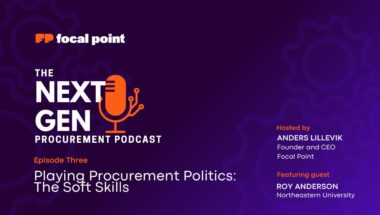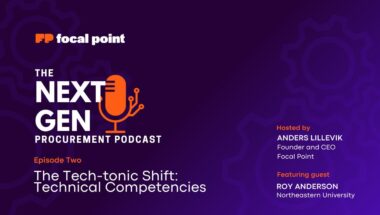In 2024, we are working in one of the most remarkable digital transformations and a more interconnected business world. The future of supplier relationship management (SRM) is undergoing a seismic shift. As companies recognize suppliers’ critical role in driving innovation, mitigating risks, and creating shared value, the need for a more strategic and collaborative approach to SRM has become paramount.
But what does this new era of supplier relationship management look like? How can your organization leverage cutting-edge technologies and best practices to revolutionize the way you engage with your suppliers and internal stakeholders? The answer lies in embracing a paradigm shift that transforms transactional relationships into dynamic, value-driven partnerships.
In this article, we’ll explore the game-changing trends and strategies that are redefining the SRM landscape. From harnessing the power of AI and data analytics to fostering a culture of trust and collaboration, you’ll discover how to unlock the full potential of your supplier network and drive long-term success in a rapidly evolving business environment.
With AI and advances in procurement platforms like Focal Point, the future of supplier management is poised for significant transformation.
These advanced technologies and automated processes will change how businesses collaborate with suppliers and internal stakeholders. Get ready to embark on a journey that will reshape how you think about supplier relationship management.
Key Takeaways
- Supplier relationship management is crucial for driving innovation, mitigating risks, and creating joint value.
- Companies can unlock substantial cost savings and improve pricing by investing in SRM technologies and processes.
- Leading procurement organizations prioritize a holistic and integrated approach to supplier management.
- Effective communication, trust, and modern SRM technology are key to success in the future of supplier management.
- Organizations must develop a supplier relationship-centric framework to drive performance and foster innovation.
Cost-Saving Process and the Future of Supplier Relationship Management
Firms spend 15-27% of their revenues on external suppliers. Yet, a significant portion of the negotiated value is lost over the contract’s duration. This underscores the need for a strategic shift in supplier management.
It’s no longer just about managing suppliers; it’s about engaging with them actively.
By investing in SRM technologies and processes, companies can achieve substantial cost savings, enhance customer pricing, and cultivate a culture of trust and collaboration.
Top procurement firms are adopting a comprehensive and integrated strategy for managing suppliers. To make it easier, they are changing to Procurement’s first full orchestration layer, where everything and everyone is in one place, one dashboard.
They recognize that fostering joint value necessitates a framework focused on supplier relationships, speed, and efficiency.
This approach propels performance, encourages innovation, and reduces risk.
By applying supplier relationship management best practices, such as emphasizing effective communication and trust and leveraging modern SRM technology, these firms are setting themselves up for success in supplier management’s future. So, where are we headed with these technological advances?
The Evolving Landscape of Supplier Relationship Management
Supplier relationship management (SRM) has significantly shifted in recent years. It’s about building strong partnerships with suppliers that benefit both parties.
In a complex and ever-changing supply chain, effective supplier collaboration and strategic management are more critical than ever and technology like AI will make this more accessible and more efficient to manage.
It has been estimated that companies that focus on building strong supplier relationships see up to a 30% increase in stability during crises.
According to McKinsey’s Procurement 2024 report, procurement leaders continue to face significant challenges, including supply chain disruptions, economic volatility, and geopolitical issues, requiring them to reassess their risk and resilience practices.
Shifting Focus from Cost Savings to Value Creation
The old view of supplier relationships as purely transactional is changing. Now, it’s about creating value. About 40% of companies see mutual benefits, like priority treatment and discounts, from working with suppliers who share their goals. By setting clear expectations and regular feedback, businesses can boost supplier performance by over 20% through better collaboration.
Seeing supplier relationships as partnerships can lead to mutual success, with companies seeing up to 25% higher growth and cost savings. Yet, only 26% of procurement professionals consider maximizing supplier relationship value a top priority in procurement KPIs. This shows the need for a mindset shift towards strategic supplier management.
Embracing Digital Solutions for Enhanced Collaboration
Technology is vital to effective SRM. Digital tools and procurement systems help companies focus on more than just price. They provide real-time visibility, efficient communication, and comprehensive supplier management. This leads to better collaboration and information sharing between companies and their suppliers.
The move to digital procurement and process orchestration has digitized some or all of an organization’s Source-to-Pay (S2P) processes.
Adding a layer of supplier management to the digital strategy is crucial to fully benefiting from supplier relationships. Integrating technology and strategic SRM practices improves supplier capabilities, reduces costs, and mitigates risks.
Key Attributes of Leading-Practice SRM Programs
Align your strategy with the key attributes of leading supplier relationship management (SRM) programs to craft a successful program.
These elements create a collaborative environment that boosts transparency, cuts costs, and ensures compliance in procurement. This approach fosters a robust partnership with suppliers.
We recommend utilizing one central platform for incoming requests and procurement.
Value Management Framework
A solid value management framework is also vital. It aligns finance, procurement, and SRM on evaluating investments and measuring return on investment (ROI). This framework aids in making informed decisions and assessing the SRM impact on business performance.
Well-Defined Organizational Structure
Leading SRM programs boast a clear organizational setup. This structure clearly outlines roles and responsibilities among sourcing, SRM, and business partners. It minimizes overlap and enhances collaboration.
This clarity in roles ensures effective governance and improves communication, leading to better supplier engagement and stronger relationships.
Opportunities for Future Growth
Identifying future growth opportunities positions your SRM program to achieve larger business goals like cost savings, revenue growth, and quality enhancements. With a clear understanding of resources and responsibilities, you can strategically plan for the future. This ensures your SRM initiatives align with the business strategy.
Executive Sponsorship and Support
Executive sponsorship is crucial for the success of the SRM program. It ensures that the function’s value matches the strategic goals set by executives. This support helps navigate challenges and drives transformation within the organization.
Proactive Strategy Aligned with Business Needs
A proactive SRM strategy aligns your solution with your business’s specific needs, not just market demands. Anticipating future requirements, you can build a strong SRM program. This approach delivers long-term value and supports strategic objectives.
Culture of Trust and Collaboration
Building a culture of trust and collaboration unlocks the potential of both internal and external resources. In high-trust companies, employees experience less stress, more energy, and higher engagement. This leads to better supplier relationships and improved performance. Trust and open communication build strong, mutually beneficial partnerships with suppliers.
Technology as a Catalyst for Improved Supplier Relationships
Technology and digital transformation are crucial for enhancing supplier relationship management (SRM) in today’s fast-paced business world. It helps streamline processes, boost collaboration, and create strategic value. This technology acts as a catalyst, allowing companies to focus on key goals, reduce risks, and meet their business objectives.
Electronic Procurement Systems for Real-Time Visibility
Electronic procurement systems are changing how businesses interact with suppliers. They automate procurement, offering real-time insights into supplier performance and inventory. This enables organizations to swiftly evaluate supplier capabilities, spot potential issues, and make timely decisions for consistent customer service.
Supplier Portals for Efficient Communication
Supplier portals act as a central point for smooth communication between buyers and suppliers. They let suppliers manage their accounts, send invoices, and talk directly with procurement teams. By simplifying communication, these portals cut down on manual work, boost efficiency, and strengthen partnerships. This leads to cost savings and increased profitability for both sides.
CRM and SCM Software for Comprehensive Supplier Management
CRM and SCM software offer a detailed look at supplier relationships. They help track supplier performance, check compliance, and pinpoint areas for betterment. By combining supplier data from different sources, these systems empower procurement teams to make decisions based on data, focus on strategic efforts, and align supplier management with business goals.
AI-Powered Automation and Decision Making in Procurement
The future of managing supplier relationships is closely tied to embracing technology as a strategic tool, particularly in AI-powered automation and decision-making.
AI is rapidly transforming the future of supplier relationship management by automating routine tasks, facilitating intelligent decision-making, and revolutionizing procurement processes.
AI algorithms sift through vast supplier data, uncover patterns, and offer actionable insights, enabling companies to streamline supplier onboarding, assess risks, improve supplier performance, and make data-driven decisions.
In the procurement context, new-frontier analytics and AI provide real-time insights for strategic planning, predictive capabilities for commodity and demand forecasting, and enhanced risk assessment and mitigation strategies.
These technologies support you as a procurement leader with supplier negotiations and data-driven insights. They automate routine tasks and offer deep category management insights.
Organizations can ensure real-time visibility, efficient communication, thorough supplier management, and data-driven decisions by integrating electronic procurement systems, supplier portals, CRM and SCM software, and AI solutions.
Moreover, AI-powered tools contribute to sustainable procurement initiatives and act as cognitive procurement advisors. To see this firsthand and learn more about AI in procurement, Schedule a demo today.
By tapping into these advanced capabilities, your company can set priorities, reduce costs, manage risks, and cultivate a culture of collaboration and trust with suppliers. This leads to a more resilient, adaptable, and profitable supply chain ready to navigate the changing business environment.
Ultimately, by integrating AI-powered automation and decision-making in procurement, organizations can significantly enhance their strategic value, drive cost savings, mitigate risks, and foster more robust, more collaborative supplier relationships, contributing more effectively to overall business objectives.
The Future of Supplier Relationship Management: Embracing Change for Long-Term Success
In conclusion, the future of supplier relationship management is about embracing change and leveraging the power of strategic partnerships to drive long-term success. As we’ve explored throughout this article, the key to unlocking the full potential of your supplier network lies in adopting a proactive, value-driven approach that prioritizes collaboration, trust, and innovation.
To recap, here are the essential takeaways for companies looking to stay ahead of the curve in the new era of SRM:
1. Shift your mindset from transactional relationships to strategic partnerships that create shared value.
2. Harness the power of advanced technologies, such as AI and data analytics, to gain real-time insights and make data-driven decisions.
3. Streamline your processes and optimize communication through electronic procurement systems, supplier portals, and integrated CRM and SCM software.
4. Foster a culture of trust, transparency, and collaboration that encourages supplier innovation and mitigates risks.
5. Align your SRM strategy with your overall business objectives to ensure maximum value creation and long-term success.
Now is the time to take action and transform your supplier relationship management practices. By embracing these key strategies and best practices, your organization can build stronger, more resilient supplier partnerships that drive innovation, reduce costs, and create a competitive edge in today’s rapidly evolving business landscape.
Don’t get left behind in the old world of transactional relationships. Seize the opportunity to revolutionize your approach to SRM and unlock the full potential of your supplier network. The future of supplier relationship management is here – are you ready to embrace it? Schedule Your Demo Today



